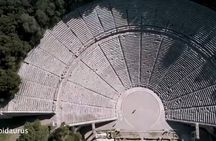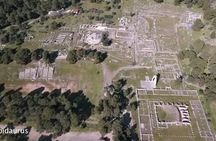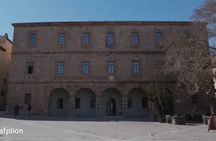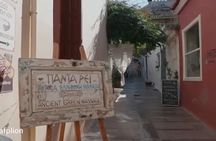
No expiration date
Easy refund
Free exchange
Easy booking
Private tour of Corinth, Nafplio, Mycenae with a Pickup
$226.97
This is an experience gift voucher. The recipient will book the experience after
they redeem the gift voucher.
Overview
This tour is unique because it offers an exclusive, personalized experience combining history, culture, and breathtaking landscapes. Unlike typical group tours, it is tailored to your interests and pace, allowing you to explore iconic sites like Nafplio, Mycenae, and Epidaurus with expert local guides who bring ancient stories to life. You’ll enjoy insider access to hidden gems, authentic local flavors, and stunning views off the beaten path. The small group size or private setting ensures comfort, flexibility, and a deep connection to Greece’s rich heritage. Whether you’re passionate about archaeology, mythology, or simply soaking up the atmosphere, this tour creates unforgettable memories through immersive storytelling and genuine hospitality. It’s not just a visit—it’s a journey through time crafted just for you.
—
Private tour of Corinth, Nafplio, Mycenae with a Pickup
Pickup included
Pickup included
Tour guide
Language: English
Human tour guide
Duration: 8 hours
- Water
- Air-conditioned vehicle
- Toilet
- WiFi on board
- Professional driver guide with knowledge of history allowed to provide only exterior insights
- Licenced professional archeologist tour guide to escort you in the sight with extra fee
- Tickets fees for the Archeological sight of Mycenae
- Tickets fees for the Archeological sight of Corinth and Archeological museum
- Tickets fees for the Archeological sight of Epidaurus
-
Corinth CanalThe Corinth Canal, connecting the Gulf of Corinth with the Saronic Gulf, was a dream dating back to ancient times. The tyrant Periander first proposed it in the 7th century BCE, but it was considered too ambitious. Instead, a paved road called the Diolkos was built to transport ships overland. Several rulers, including Julius Caesar and Nero, attempted the project, but it wasn’t until 1881 that construction finally began under Greek and French engineers. Completed in 1893, the canal stretches 6.4 kilometers and cuts through the narrow Isthmus of Corinth. Though too narrow for modern large ships, it remains a vital passage for smaller vessels and a major tourist attraction. The canal symbolizes Greek persistence and engineering ambition spanning millennia.
-
Ancient Corinth (Archaia Korinthos)Ancient Corinth was a wealthy and powerful Greek city, located on the Isthmus connecting mainland Greece to the Peloponnese. Known for its commerce, art, and the Temple of Aphrodite, it thrived in both the Classical and Roman periods. In 146 BCE, it was destroyed by the Romans but was rebuilt by Julius Caesar in 44 BCE as a Roman colony. The city regained prominence, becoming a major urban and administrative center. Apostle Paul visited Corinth around 50 CE during his second missionary journey. He stayed for 18 months, preaching and establishing a Christian community. His letters to the Corinthians, now part of the New Testament, address issues of morality, unity, and faith, offering insight into early Christian life. The ruins of Corinth today, including the Bema where Paul likely stood, are key to both ancient Greek and Christian heritage.
-
Acrocorinth, the acropolis of ancient Corinth, is a towering rock rising over 570 meters above the city, offering strategic views of the surrounding plains and seas. It was continuously fortified from antiquity through the Middle Ages due to its key defensive position. In ancient times, it was home to the Temple of Aphrodite, linked to the city's prosperity and myths. The fortress was later expanded by Romans, Byzantines, Franks, Venetians, and Ottomans, each leaving their mark on its walls and gates. During the medieval period, it served as the seat of the local ruler and a vital military stronghold in the Peloponnese. Today, Acrocorinth stands as a powerful symbol of Corinth's historical importance, blending ancient mythology with centuries of military history, and offering breathtaking views along with layers of architectural remains from different civilizations.
-
The Ancient Theatre of EpidaurusThe theater of Epidaurus, built in the 4th century BCE, is one of the best-preserved ancient theaters in Greece and a masterpiece of Greek architecture. Designed by Polykleitos the Younger, it was part of the sanctuary of Asclepius, the god of medicine. The theater could seat around 14,000 spectators and was used for dramatic performances that were considered part of the healing process. Famous for its exceptional acoustics, the theater allows even a whisper from the stage to be heard clearly at the highest seats. It reflects the Greek ideal of harmony between architecture and nature, perfectly blending into the surrounding landscape. Rediscovered and excavated in the 19th century, it remains in use today for performances during the annual Epidaurus Festival, continuing its ancient tradition. The theater stands as a symbol of the enduring legacy of Greek drama, healing, and aesthetics.
-
MycenaeMycenae, a major center of Greek civilization during the Late Bronze Age, flourished between 1600–1100 BCE. It was the seat of the powerful Mycenaean kings and gave its name to the entire civilization. Surrounded by massive Cyclopean walls, Mycenae featured grand palaces, royal tombs like the famous Treasury of Atreus, and rich grave goods, reflecting its wealth and power. According to myth, it was the kingdom of King Agamemnon, leader of the Greeks in the Trojan War. Mycenae’s influence extended across the Aegean, with strong trade and military presence. The city declined around 1100 BCE, likely due to internal unrest and external invasions. Rediscovered in the 19th century by Heinrich Schliemann, Mycenae revealed treasures that confirmed its legendary past. Today, it stands as a symbol of early Greek civilization and heroic mythology, bridging myth and archaeology.
-
NafplioNafplio, a picturesque coastal town in the Peloponnese, is famous for its rich history, stunning architecture, and charming atmosphere. It was the first capital of modern Greece after independence in 1821 and served as a political and cultural center. Nafplio is known for its impressive fortresses, including Palamidi, a massive Venetian castle perched on a hill, and Bourtzi, a small fortress on an islet guarding the harbor. The town’s narrow streets, neoclassical buildings, and lively squares attract visitors seeking a blend of history and beauty. Nafplio played a key role in the Greek War of Independence and hosted many important historical events. Today, it’s a popular tourist destination celebrated for its seaside promenade, vibrant cafes, and close proximity to archaeological sites like Mycenae and Epidaurus, making it a gateway to Greece’s ancient and modern heritage.
How it works?
01
—
You choose from 10,000+ experience gifts
02
—
We deliver the eVoucher or the Physical box to the recipient
03
—
Recipient books the experience and creates unforgettable memories!
Private tour of Corinth, Nafplio, Mycenae with a Pickup
$226.97
This is an experience gift voucher. The recipient will book the experience after
they redeem the gift voucher.
How it works?
01
—
You choose from 10,000+ experience gifts
02
—
We deliver the eVoucher or the Physical box to the recipient
03
—
Recipient books the experience and creates unforgettable memories!




